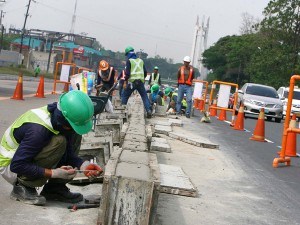The latest sovereign ratings upgrade the Philippines won from Standard & Poor’s (S&P) this week gives the country more than just bragging rights for having earned its highest credit rating ever.
Officials said the improved rating, which they claimed represents the international community’s more favorable view of the Philippine economy, should translate into tangible benefits, specifically more infrastructure and social projects for the government and more jobs for Filipinos.
“This vote of confidence from international investment analysts … raises our international competitiveness and further increases our attractiveness to foreign investors,” Budget Secretary Florencio Abad said in a statement on Friday.
“The positive outlook on our investment position will in turn significantly aid our ability to generate more jobs and livelihood opportunities,” he said.
Raised 2 notches
S&P raised the Philippines’ credit rating to two notches above investment grade on Thursday, the first debt-watching agency to do so, saying reforms are likely to continue beyond the administration of President Benigno Aquino III.
S&P upgraded the Philippines’ foreign long-term debt by one notch to BBB from BBB-, and foreign short-term debt to A-2 from A-3, with a stable outlook, saying the rating reflects the country’s strong external liquidity and investment position, and effective monetary policy framework.
A credit rating is an evaluation of the creditworthiness of a debtor, whether a company or a government, made by a credit rating agency of the debtor’s ability to pay back the debt and the likelihood of a default.
A sovereign credit rating is the credit rating of a national government and indicates the risk level of the investing environment of a country, which is used by investors looking to invest abroad.
Junk-debt status ends
Last year, when the Philippines first achieved “investment grade” status with all the Big Three credit rating agencies, economic managers said this resulted in a considerable rise in foreign investors scouting for new ventures in the country.
Many institutional investment funds are banned by their own internal rules from doing business in countries with “junk” credit ratings. But with last year’s string of upgrades, the Philippines finally ended its long history of junk-debt status and made it into the maps of these investment funds.
In 2013, the Philippines got investment grade status first from Fitch Ratings, second from S&P and then from Moody’s Investors Service.
Foreign direct investments, the kind of money that funds the construction of new factories, rose by 20 percent in 2013, data from the Bangko Sentral ng Pilipinas (BSP) showed.
As a result of the new S&P upgrade, Abad said the trend of more investments coming into the country would most likely continue.
The Philippines’ credit score with Moody’s Investors Service and Fitch Ratings, the two other major credit rating firms, remains at their respective minimum investment grades. Moody’s has a “positive” outlook for the Philippines, which means an upgrade may be given in the next 12 to 18 months.
“[The upgrade is a] clear testimony of sustained improvement in the macro economy, the financial system and public finance,” BSP Deputy Governor Diwa C. Guinigundo said.
Vote of confidence
S&P’s decision to skip the usual process of putting the country on “positive” watch before granting an upgrade serves as a vote of confidence for the administration’s policies, Guinigundo said in a text message.
The upgrade, according to S&P, was “based on our assessment that even though a change of administration after the presidential elections in 2016 represents some uncertainty for reforms, the risks have shifted toward maintaining the impetus and direction of the process, away from a potential reversal or abandonment of advances achieved to date.”
It noted improvements in structural, administrative, institutional and governance reforms in the Philippines.
The more direct impact of the upgrade, however, will come in the form of lower borrowing costs for the government, given the perception of its improved ability to repay its loans.
This means lower interest rates for government loans, which reduce the strain of debt servicing on taxpayers. Lower interest rates make it cheaper for the government to spend more on new infrastructure projects and other social projects that focus on education and healthcare.
The Aquino administration wants to ramp up spending on infrastructure projects to the equivalent of 5 percent of the gross domestic product (GDP) by 2016—double the planned 2.5 percent of GDP last year.
S&P’s upgrade is also expected to make it cheaper to bankroll reconstruction projects in areas affected by Supertyphoon “Yolanda.”
Business also benefits
Government IOUs are also used by banks as benchmarks for the pricing of their own loans to businesses and households. Lower interest rates on state-issued debt, therefore, will mean lower rates for bank loans. This makes it easier for companies to expand their own businesses, which should let them hire more people. Households would also benefit as lower rates make personal loans for car and home purchases more affordable.
The business sector should also benefit from the upgrade. The large companies whose ratings have been upgraded by S&P have been constrained by the Philippines’ sovereign rating. A higher grade for the Philippines means higher ratings for big firms like Philippine Long Distance Telephone Co. (PLDT).
Other companies rated by S&P were the state-owned Development Bank of the Philippines, Power Sector Assets and Liabilities Management Corp. (PSALM) and National Power Corp. (Napocor).
PLDT’s rating was upgraded to BBB+ or one notch higher than the national government’s, while the three state-led firms earned BBB ratings.
RELATED STORIES
What Went Before: PH’s credit ratings through the years
